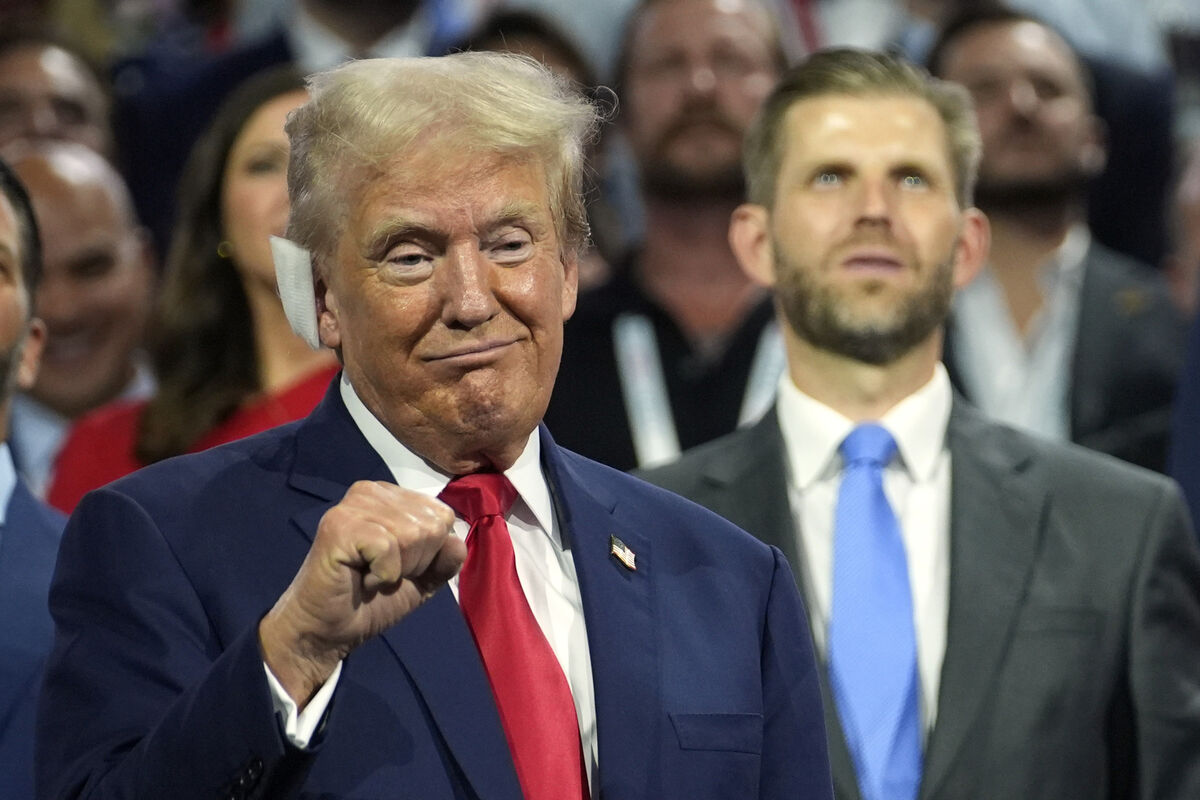Shooter Thomas Matthew Crooks grazed the former president’s ear, killed one spectator, and seriously injured another, and politicians and media figures rightly decried the terrifying incident, heralding it as a sea change in American politics.
In Britain, threw dignity to the ground, declaring “Today, we are all MAGA” and innumerable British MPs put their own country’s political culture under the microscope, citing tales of being jostled and booed during June’s campaign trail: a tawdry spectacle of false equivalence one can only term onedownmanship.
Mostly, however, talking heads hurdled to tout the incident as not merely the defining, killer blow of the 2024 election, but quite possibly a watershed in world history.
Evan Vucci’s photo of Trump raising a defiant fist to the roaring crowd was instantly ubiquitous, drawing immediate comparison with the iconic image of GIs raising the stars and stripes in Iwo Jima.
And pundits everywhere united to say aloud, as if with one clear voice: this was not merely the moment Trump became president, it was one of those moments that changes everything.
Except — it didn’t, did it?
Perhaps you felt it too, that sense that something’s come unstuck in the way the news is processed and reported. Because, for all that initial rush of coverage, and the mind-bending friction we all felt as we first saw those images coming in from Pennsylvania, it didn’t seem to last very long.
Whisper it, but this — a credible attempt on the life of the frontrunner for the American presidency — very quickly bore the stale stench of something that wasn’t quite news.
There was something sluggish and inert about the coverage, and soon, a dearth of any coverage at all.
Putting aside the political considerations and electoral mathematics of those first 24 hours, can anyone truly say there’s been much since, not least a proper interrogation of just how close we came — micro-seconds? nanometres? — to seeing Donald Trump shot dead on live television.
Polling almost immediately confirmed this suspicion, as Trump saw a near negligible uptick in ratings.
In one poll — the Morning Consult survey taken the day after the incident — Trump registered a 1% decrease from his pre-shooting tally nationwide, conjuring the notion that a statistically significant portion of voters were happy to back Trump before someone tried to shoot him, but lost interest in doing so afterward.
None of this fit the narrative, but no matter. It was quickly presumed that Trump’s base would keep the story going themselves, contriving some imagined connection between the shooter and Biden, especially at the Republican National Convention in Milwaukee two days later.
There was indeed some talk of Biden’s anti-Trump rhetoric being incendiary, and Trump did attempt a nebulous through-line in his keynote, saying “they” wanted him dead because he spoke for the American people.
It barely registered. Perhaps Republicans are just in a poor place to capitalise on any panic over gun violence, given that Democrats have repeatedly pledged to ban the AR-15 Crooks used, moves the GOP have themselves vociferously, and unilaterally, opposed.
Or maybe Trump, a historically unpopular candidate who just happens to have the good luck to be running against a man currently incapable of sentience, has simply acquired every single vote he can possibly get from the American electorate, and not even the graze of a sniper’s bullet can move that needle any further.
Or maybe … it’s something more stupid altogether.

The motivation behind the suspect’s actions is still, a week later, so inscrutable as to defy the sort of ongoing news coverage that keeps these kinds of stories alive.
There was no manifesto, statement, or political thesis anyone could find to connect him to, save a few interviews with old classmates who described him as a right-wing loner, habitually bullied; a gun nut dismissed from his school’s rifle team for being a dangerously bad shot.
Crooks was, indeed, a registered Republican but had also, confusingly, donated $15 to Biden’s campaign on the day of his inauguration in 2021.
To some, this odd timing suggested it was more likely the result of a lost wager than a sincere decision by an avowed conservative to finally support a liberal president’s campaign on the day he was literally sworn in to that very job.
Crooks was also, crucially, totally absent from any social media — very nearly a death sentence for the kind of follow-up reporting now ubiquitous for such stories.
And here we reach the rub.
It seems possible that this story, inarguably one of the most sensational in a decade of Trump’s chaotic stranglehold of the world’s press, withered on the vine simply because all the above factors made it near impossible to keep the story alive in the public mind.
He cited a video by Jason Pargin on TikTok, about the similarly memory-holed 2020 Nashville RV bombings, in which Pargin concluded, “while there was plenty for us to talk about, there was nothing for us to argue about”.
Here there was no piecemeal information to offer in dribs and drabs, no clear political dimension to turn the story just the right type of tribal.
In the days of algorithmically, ad-driven news cycles, this may have proven fatal. No detail and no arguments means no stories and no clicks, which means no ads, no money, and no reason not to change the subject already.
By Thursday, all talk was of Biden’s covid diagnosis, and more people were talking about Tenacious D sacking Kyle Gass for an off-colour joke about the shooting, than the shooting itself.
It was, undoubtedly, a shot heard round the world, but it may well have whizzed just past us all.

